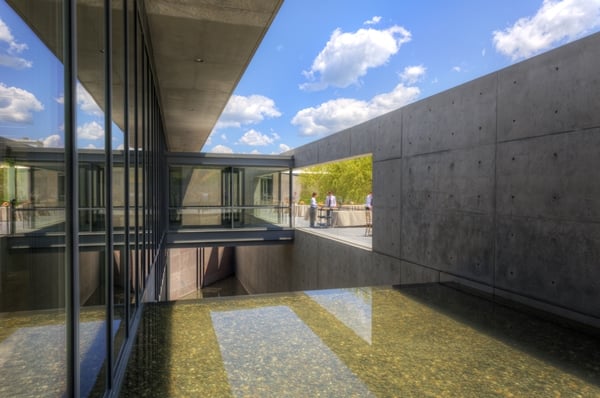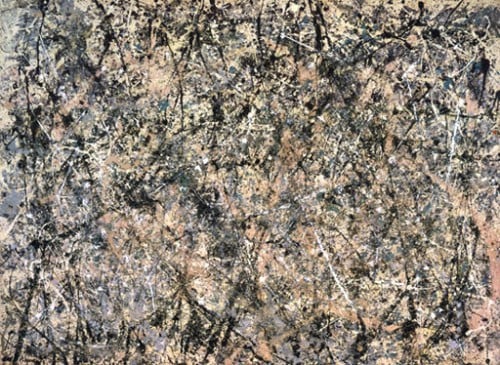Art & Exhibitions
Art World Report Card: Abstract Expressionists at the New Clark Art Institute
New England's Clark Art Institute reimagines itself as the Bilbao of the Berkshires.

Photo: Tucker Blair
New England's Clark Art Institute reimagines itself as the Bilbao of the Berkshires.

Alexandra Peers

We are strolling, ever so slowly, through the new-and-improved Clark Art Institute museum in the leafy Berkshires. Various architecture experts are droning on, in English and Japanese, about granite vs. concrete, movable walls, mesh, flexible lighting and “a dialogue with the landscape.” It occurs to me that tours of Hell are probably narrated by architects.
After 14 years of talking, of battles, and of construction, and in one of the more ambitious reimaginings of a regional museum ever, the art-rich Clark has opened a new building, plopped a lake behind it and expanded to a 140-acre campus.
It opens July 4, and it is magnificent—mostly—but we’ll get to that.
To remind you, the 50-something-year-old Clark is the Williamstown, Massachusetts, institution that owns more than anyone’s fair share of Impressionism and post-Impressionism, a silly-good trove of it. There’s a sorority of Renoirs, several works by Degas, plus decorative arts and top works by Homer, Bouguereau, Sargent, many more. Gorgeous stuff, all collected by Sterling and Francine Clark, they of the Singer sewing fortune.
Adjacent to the building hosting those paintings the Clark has now added (at a cost it estimates at under $150 million), a 42,650-square-foot visitor center designed by Japanese architect Tadao Ando. The building addition is, at first glance, familiar, even the fashion of these times: It’s a long, low-slung modernist white and gray structure with big windows, blonde-wood floors, and metal accents. On second glance, there is an undeniable grace and loveliness here. The park behind the Center will be open 24 hours, Clark director Michael Conforti explains, and the lake—actually, three linked reflecting pools—will be frozen over in winter for ice skating. How Currier & Ives! Ando has shown respect for the hills and history of the Berkshires as much as for the Clark’s art.
Would that I could type that paragraph without a footnote, but here it is. The new entrance to the Clark is concealed behind Ando’s immense “signature” wall, a long barrier of pink-gray granite shaped like a 7. If this seems to make no sense in the verdant hills of Massachusetts, bingo. Turns out it was a hard-fought compromise between Ando, who wanted to use concrete, and Conforti, who insisted that the red stone from the Clark’s 1973 Brutalist-style annex be used to tie the compound together. Nobody won here.
The principals of the project are surprisingly open about the problems they faced. “We butted our heads from time to time,” said Ando, through an interpreter. (The architect is best known in the US for the Modern Art Museum of Fort Worth and the Pulitzer Foundation building in St. Louis.) “Michael sent me emails every three days, every day . . . bombarded” me. Ando said he told his staff “Don’t look at his e-mails.” Conforti admits he was “the client from hell but says he didn’t quite e-mail every day.
In a private talk later, Conforti admits that some find the wall “weird.” His word. But the wall is “the curtain that rises” on the great new Ando building and the hill that climbs beyond it, he defends. It creates a massive element of surprise that actually pays off. Indeed, once you do step beyond the architectural folly, the acre of lake opens up in an almost cinematic reveal. It’s gorgeous. (For his part, Ando says he went into “a blackout” rather than do the wall as asked, but that, in the end “the past must be respected.” He dyed a shock of his hair pink for the patron’s opening, in homage.)
In all the fuss about the new building, the collection’s re-installation by architect Annabelle Seldorf has been a bit lost in the shuffle. It’s very subtle, it’s very good. There are skylights and completely unexpected wall colors—the paint has names like Radicchio, Black Pepper, Pelt, and Beguiling Mauve. Against these hues, the art rocks. A room of Renoirs, paintings mostly of pretty girls with abundant curls—it looks like the beauty salon for a one-percenter’s daughter from the 1880’s—is actually painted in an Easter purple. If the effect is a tiny bit saccharine, well, so was the artist’s work, and it’s a room many people could die in quite happily.
The institution opens with fireworks July 4, but they’ll be far from over on Independence day. In August the Clark unveils a show of Abstract-Expressionist paintings. Given that summer is not traditionally a blockbuster time for museum shows, you might fairly ask what also-ran Ab-Exes is the Clark going to pull out of a musty closet? Just a no-name like Jackson Pollock and his Number 1, 1950, Lavender Mist. The National Gallery is loaning the masterpiece, along with works by Johns, Ryman, Twombly. The Clark, enticingly, promises an “unconventional arrangement” and “alternative narratives of postwar art.”
So, in answer to the central question of whether the “Next Clark” has upped the Berkshire region’s cultural cred, made it an even more compelling destination, and kicked the institution up into a new art-world bracket, the answer has to be yes. Museum architects, like doctors, should “First, do no harm,” and that credo is honored here and more.

Jackson Pollock Lavender Mist (1950) to go on view at the Clark in August. Courtesy National Gallery of Art.
At a panel for patrons and donors last week, Conforti leaned forward in his chair, excitedly, as if an idea has just occurred to him. Tom Krens, for years director of the Guggenheim Foundation, had just toured the new Clark campus, he explained. Krens told Conforti triumphantly, “It is another Bilbao!” It was perhaps the highest compliment Krens could give, in that the Guggenheim Bilbao Museum transformed the region of Spain where it was headquartered and even transformed thinking about the power of museums. No, says Conforti, who we suspect has been waiting to work this phrase into a conversation for 14 years: “It is Berkshire Bilbao.”
Yes, perhaps it is.